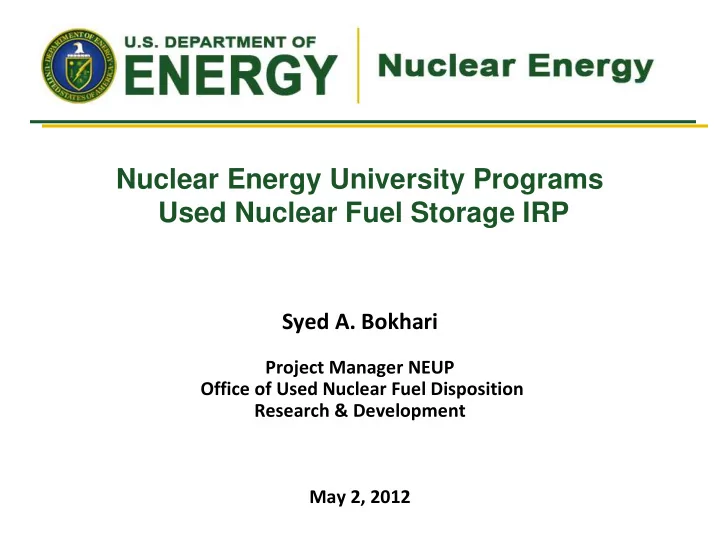

Nuclear Energy University Programs Used Nuclear Fuel Storage IRP Syed A. Bokhari Project Manager NEUP Office of Used Nuclear Fuel Disposition Research & Development May 2, 2012
Overview of UFD IRP Material degradation issues associated with long term behavior of high burn up used nuclear fuel (>45 gigawatt-days/metric ton) is of specific interest. This IRP focuses on areas of canister hardware not covered in the earlier IRP and a more efficient system for packaging of canisters. This IRP is also focused on large canisters which have proven efficient for the utilities in managing their used nuclear fuel inventory. There are nine areas of interest in the IRP • High burnup impacts on used fuel • More efficient packaging of canisters for transportation and storage to allow for a multitude of canister sizes (not just big) This IRP is an extension of earlier IRP that focused on hydride effects and creep of fuel cladding, canister corrosion, and advanced in-situ monitoring system. 2
IRP Areas Of Interest for UFD 1. Fuel Assembly Hardware • Degradation of assembly hardware for holding fuel rods to maintain geometry under extended storage with high radiation and temperature • Maintenance of fuel assembly geometry is important to address the criticality issues • Stress corrosion cracking 3
IRP Areas Of Interest for UFD 2. Neutron Poisons • Thermal Aging effects • Embrittlement and cracking • Creep • Corrosion (blistering) Aluminum, Alloys or Stainless Steel Ceramic Materials Impregnated with boron Impregnated with boron 4
IRP Areas Of Interest for UFD 3. Bolts and Seals of casks and possible Canisters • Stress corrosion cracking • Thermo-mechanical fatigue of bolts and seals • Atmospheric corrosion (marine environment) • Aqueous corrosion • Freeze/Thaw behavior of concrete casks • Corrosion of steel bars 5
IRP Areas Of Interest for UFD 4. Reducing Canister Drying Times • It is believed that drying a canister is important to protect the internal canister components from degradation • Drying time is time consuming and costly for the utilities • Two methods are currently used, vacuum and hot helium circulation • There are concerns about effectiveness of either method for drying the canister before sealing 6
IRP Areas Of Interest for UFD 5. Adding Materials in a Canister to Maintain Geometry Configuration • Geometry configuration is important to protect against criticality • Maybe canister could be filled with sand, heat resistant epoxy or some other material that would keep assemblies from shifting for failing • It wouldn’t matter if degradation of the assembly hardware would fail • Existing canisters would not have to be opened for shipping & disposal 7
IRP Areas Of Interest for UFD 6. Sealing Canisters without welding • Although mostly automated, welding is difficult and time consuming • Significant set up time can cause undesirable dose to workers • Non-destructive testing of the weld on the canister is difficult to perform • This seeks sealing process other than welding to seal the canisters 8
IRP Areas Of Interest for UFD 7. Rapid Welding of Canisters • Welding has problems as discussed in #6 • Welding techniques from other industries could possibly be used to rapidly weld the canister without causing the dose to the workers – Friction Stir Welding, Laser welding at a distance, etc. • The final outcome would be to weld the canisters quicker and more reliably with less dose to workers than is currently done. 9
IRP Areas Of Interest for UFD 8. Rapid Canister Processing • The handling of canisters can be lengthy and costly – They are received, placed in an cask and submerged in the pool – They are systematically loaded with assemblies in the pool – Removed from the pool, sealed and dried – Placed in a transfer cask and placed in a storage cask or placed in a transportation cask and removed from the site • If this process could be improved, it would greatly reduce costs and dose 10
IRP Areas Of Interest for UFD 9. Numerical modeling for more efficient loading • Loading of canisters in pools has a number of possibilities which generally range from hottest to middle or coolest from the pool or even short loading (not fully loading) a canister. • The outcome would be that given the fuel characteristics in the pool, the numerical model would determine the optimal loading for the utility to manage the pool and transport and store the fuel 11
Summary Conclusion • This IRP along with the earlier IRP will provide a comprehensive look at all aspects of degradation of high burn up fuel assembly, canister, and storage cask hardware in extended storage • Logistical issues of efficient canister handling and loading with used nuclear fuel will be addressed by identifying more innovative systems to achieve maximum efficiencies and reduce radioactive dose during fuel handling 12
Recommend
More recommend